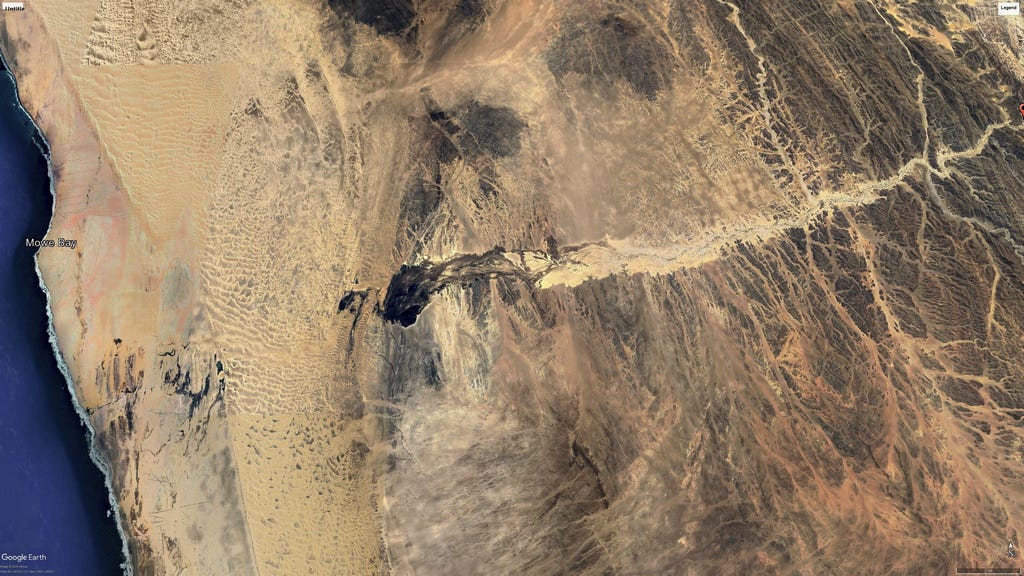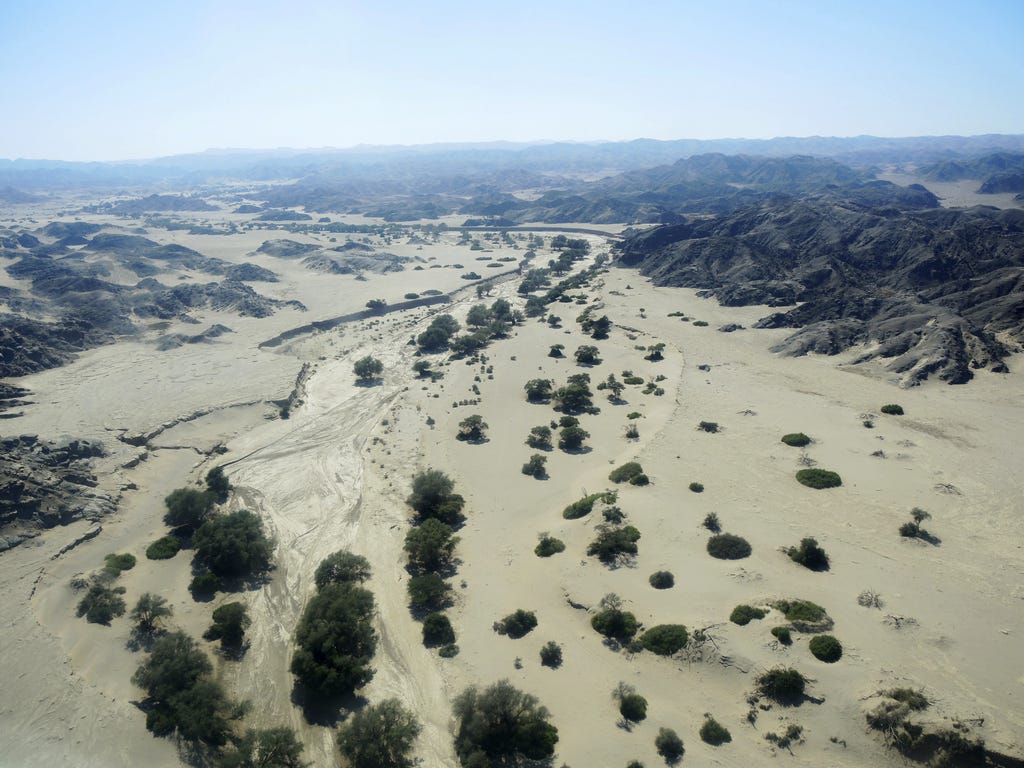Namibia is a land of dry rivers, bounded on the north and south by the only permanent rivers that touch its territory, the northern Kunene and the southern Orange Rivers. In the 1400 km between these boundaries, not a single river regularly flows to the sea. Oh, there is plenty of evidence that many once did, but under the present arid climate, only the Kuiseb, Swakop and the Hoanib still do so with significant frequency. Kalahari sand washed down the Orange River is moved onshore by littoral currents and piled into dunes by the wind, a wind that alternates seasonally from the southwest and southeast, drifting an apparently endless supply of sand in a net northward direction, like a colossal Zen garden of neatly raked rows. Repeated wetting and drying brings iron and manganese oxides to the grain surfaces and the dunes become a deeper red the farther north and inland they have traveled.
The battle between water and sand has been going on a very very long time, and at least in the southern half of Namibia, the sand has won, over and over, creating a huge sand sea that stretches northward 350 miles from the Orange River to the Kuiseb River. But the Kuiseb still runs every few years, and when it does, it sweeps its channel clear of dune sand, stopping the northward march of the dunes at its southern riverbank, a sharp line drawn into the sand, uncrossable by the dunes. In being swept to the sea and once again deposited on beaches, the red color is bleached, and the dunes north of the Kuiseb are pale or white. By the time the sand reaches the Kunene River on the Angola border, it has once again become reddish.

The northward drift of dunes has been going on for millions of years, overwhelming most of the other rivers that once ran to the sea and causing them to pond behind the dunes on the rare occasions that they carry water. The Tsondab and Sossus Rivers have battled mightily, pushing the sand seaward like fingers poking into a balloon, forming “vleis” studded with dead acacia trees and crusted with salt, ponding every few years before the relentless desert wind reduces the water to a salt flat.

The region through which the Hoanib River "flows" is an austere and harsh land of dark, stony, broken hills and sand-filled valleys, speckled with a spare vegetation of the few shrubs and grasses that can persist under these trying conditions. From the air, you might as well be flying over the moon. This is not where you might expect to find large animals, yet there they are---- elephants, alongside oryx, giraffe and springbok, all defying probability. Although these animals roam away from the river too, it is the riverbed that brings them life. Rains falling on the highlands occasionally sweep through to form huge, dark marshy areas behind the coastal dunes. But even in their normal dry state, there is also a hidden underground river that creeps seaward in the deep, sandy riverbed, coming to the surface in both the large marsh landward of the dunes and smaller marshes just seaward of the dunes, water that has percolated through the sands and finally percolates into the sea. By the time this water joins the sea, it may be centuries old.
This underground flow sustains a riverside woodland of shrubs, vines and winter thorn acacias with trunks thicker than a man is tall, and a crown spread wider than high. They stand like soldiers all along the dry riverbank, and sometimes in the riverbed itself, for the channel is undependable, and shifts back and forth across the sand-choked valley bottom. Here and there, the shifting has cut a bank, exposing a tree’s taproot and side roots, looking for all the world like an upside-down tree. The trunks of trees in the stream bed are buried in a meter of sand, their bases invisible. Winter thorn is a blessing for these arid lands, for it bears its tiny leaves and convoluted pods during the dry season when animals have the greatest need and is leafless during the abundance of the rainy season. Elephants and giraffes dining on the pods have reached so high for so long that the lowest branches are almost out of their reach.

To the human desert traveler, winter thorn is a mirage come to life, a miracle and a respite from a harsh, sun-blasted land, welcome patches of shade and thin threads of green.
To the animals in the dry rivers of Namibia, winter thorn is the gift of life.






This is a fascinating part of the earth. And, as ever, I am smitten with your botanical art.
Another gem of an article. Being a desert guy I deeply appreciated it. All the descriptions seem so "normal" to me, life as it should be. My constant hope is to return to the arid lands but my wife wouldn't prosper in that environment. Do you ever find yourself wanting to return to one of the dry lands? The so-called "waterless wastes" ?